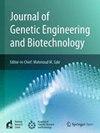Detection of FMR1 CGG Repeat Expansions Using Buccal Swab and Blood Samples of Children With Intelectual Disability in A Resource-Limited Country
IF 2.8
Q3 Biochemistry, Genetics and Molecular Biology
Journal of Genetic Engineering and Biotechnology
Pub Date : 2025-10-02
DOI:10.1016/j.jgeb.2025.100582
引用次数: 0
Abstract
Fragile X Syndrome (FXS), the most common inherited intellectual disability, is caused by CGG-repeat expansions in the FMR1 gene. In resource-limited settings such as Indonesia, the absence of systematic screening programs complicates early detection. This study compared the performance of buccal swab and blood samples in detecting FMR1 repeat expansions to facilitate non-invasive screening. A total of 164 male students with intellectual disabilities in Jakarta provided paired buccal swab and blood samples. Conventional PCR was used for initial screening, followed by Triplet-Primed PCR (TP-PCR) with Melt Curve Analysis (MCA) and sizing confirmation by fluorescent TP-PCR and capillary electrophoresis. Conventional PCR identified 159 normal alleles, three grey zones, and two full mutations, resulting in an FXS prevalence of 1.22 %. A perfect concordance was observed between buccal swab and blood samples (Cohen’s Kappa = 1.000). Additional TP-PCR MCA analysis on 80 selected samples revealed inconsistencies in buccal swab results, with 12 cases classified as indeterminate, suggesting potential DNA quantity and/or quality issues. These findings indicated that buccal swabs are a feasible, non-invasive sampling method to screen FXS via conventional PCR, though further optimization is required for TP-PCR MCA. This study represents the first FXS screening in Jakarta, emphasizing the importance of early detection and scalable genetic testing strategies, particularly in resource-limited settings.
资源有限国家智障儿童口腔拭子和血液样本检测FMR1 CGG重复扩增
脆性X综合征(FXS)是最常见的遗传性智力残疾,是由FMR1基因的cgg重复扩增引起的。在印度尼西亚等资源有限的国家,缺乏系统的筛查方案使早期发现变得复杂。本研究比较了口腔拭子和血液样本检测FMR1重复扩增的性能,以促进非侵入性筛查。雅加达共有164名智障男学生提供了配对的口腔拭子和血液样本。采用常规PCR进行初步筛选,然后采用熔体曲线分析(MCA)的三重引物PCR (TP-PCR)和荧光TP-PCR和毛细管电泳进行施胶鉴定。常规PCR检测到159个正常等位基因,3个灰色区,2个全突变,FXS患病率为1.22%。口腔拭子与血液样本完全吻合(Cohen’s Kappa = 1.000)。对80个选定样本的额外TP-PCR MCA分析显示口腔拭子结果不一致,其中12例分类为不确定,提示潜在的DNA数量和/或质量问题。这些结果表明,口腔拭子是一种可行的、无创的取样方法,通过传统的PCR筛选FXS,尽管TP-PCR MCA需要进一步优化。这项研究代表了雅加达的第一次FXS筛查,强调了早期发现和可扩展的基因检测策略的重要性,特别是在资源有限的环境中。
本文章由计算机程序翻译,如有差异,请以英文原文为准。
求助全文
约1分钟内获得全文
求助全文
来源期刊

Journal of Genetic Engineering and Biotechnology
Biochemistry, Genetics and Molecular Biology-Biotechnology
CiteScore
5.70
自引率
5.70%
发文量
159
审稿时长
16 weeks
期刊介绍:
Journal of genetic engineering and biotechnology is devoted to rapid publication of full-length research papers that leads to significant contribution in advancing knowledge in genetic engineering and biotechnology and provide novel perspectives in this research area. JGEB includes all major themes related to genetic engineering and recombinant DNA. The area of interest of JGEB includes but not restricted to: •Plant genetics •Animal genetics •Bacterial enzymes •Agricultural Biotechnology, •Biochemistry, •Biophysics, •Bioinformatics, •Environmental Biotechnology, •Industrial Biotechnology, •Microbial biotechnology, •Medical Biotechnology, •Bioenergy, Biosafety, •Biosecurity, •Bioethics, •GMOS, •Genomic, •Proteomic JGEB accepts
 求助内容:
求助内容: 应助结果提醒方式:
应助结果提醒方式:


